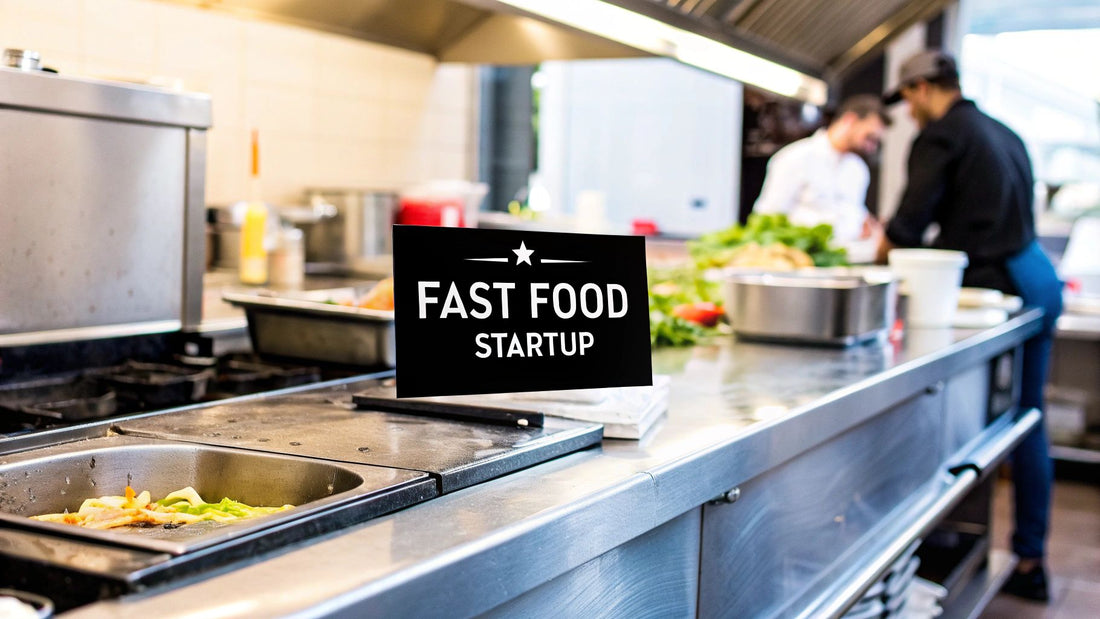
Starting a Fast Food Restaurant: Your Step-by-Step Guide
Share
So, you have an idea for a fast food joint. That's the easy part. The real work is turning that spark of an idea into a business that can not only survive but thrive. It all starts with a rock-solid plan, deep-dive research, and a brand that stands for something before you even think about firing up the grill. As an aspiring restaurant owner, staying informed about the latest industry trends and equipment is your first step toward success.
Nailing Your Restaurant's Winning Formula
Long before the first customer walks through the door, the fate of your restaurant is being decided. This foundational stage is all about carving out your unique identity in what is, let's be honest, a very crowded market. Get this right, and everything else falls into place.
What’s Your Big Idea? Defining Your Concept
First things first: what are you selling, and why should anyone care? You need to crystallize your core concept. Are you going to be the local hero for gourmet burgers, a go-to spot for healthy wraps and salads, or the only place in town for authentic international street food? This concept is your North Star—it guides every single decision you'll make, from your menu and equipment purchases to your marketing.
Think hard about what makes you different. Is it your grandma's secret fried chicken recipe? A serious commitment to only using ingredients from local farms? Maybe you're leaning into tech, with self-service kiosks and a super-efficient delivery system.
Your unique selling proposition (USP) needs to be sharp and clear. It’s not enough to say you have "great burgers." A better USP is "smash burgers made with a custom blend of brisket and short rib, ready in under three minutes." See the difference? One is generic, the other is a promise.
Doing the Homework: Deep Market Research
Once you've got your concept dialed in, it’s time to see if it has legs. Market research isn't about getting a pat on the back; it's about finding out what your community is actually hungry for.
You need to get into the weeds on a few key things:
- Who Lives Here? Analyze the local demographics. Are you in a college town full of students looking for cheap, late-night food? A business district with professionals who need a quick lunch? Or a suburb packed with families who want an easy dinner option?
- What Are People Eating? Look at the trends in your area. Is there a growing demand for plant-based meals, gluten-free options, or exotic global flavors? You don't want to open a steakhouse in a neighborhood that's gone vegan.
- Who's the Competition? Scope out every direct and indirect competitor. Go eat at their places. Check out their menus, time their service, and read every single one of their online reviews. You're looking for the gaps—the things they aren't doing that you can do better.
Don't forget to look at the big picture. The global fast food market hit roughly USD 822.66 billion and is expected to grow by about 4.9% a year through 2032. North America is the giant in this space, with a massive 35.3% market share, all thanks to our need for fast, convenient food. This tells you two things: the market is huge and competitive, but the demand is incredibly strong. You can explore more about these market dynamics to really sharpen your strategy.
Your Blueprint for Success: The Business Plan
Think of your business plan as more than just a document to get a loan. It's your operational roadmap. It’s where you translate your vision into a concrete, step-by-step strategy for how you'll launch, run, and grow the business.
A well-crafted business plan is the single most important document for any aspiring restaurateur. It not only secures funding but also acts as a guide to keep your business on track during the chaotic first years of operation.
A good plan forces you to think through every detail. Your executive summary needs to be a compelling, one-page pitch that hooks readers with your mission. The market analysis section is where you show off all that research you did, proving there's a real audience for your food.
And, of course, the financial projections. This is where the rubber meets the road. You need realistic numbers for startup costs, projected revenue, and a break-even analysis. This proves your dream isn't just a dream—it's a viable, profitable business. This document will be your most powerful tool for turning your idea into a reality.
Securing Capital and Navigating Legal Waters
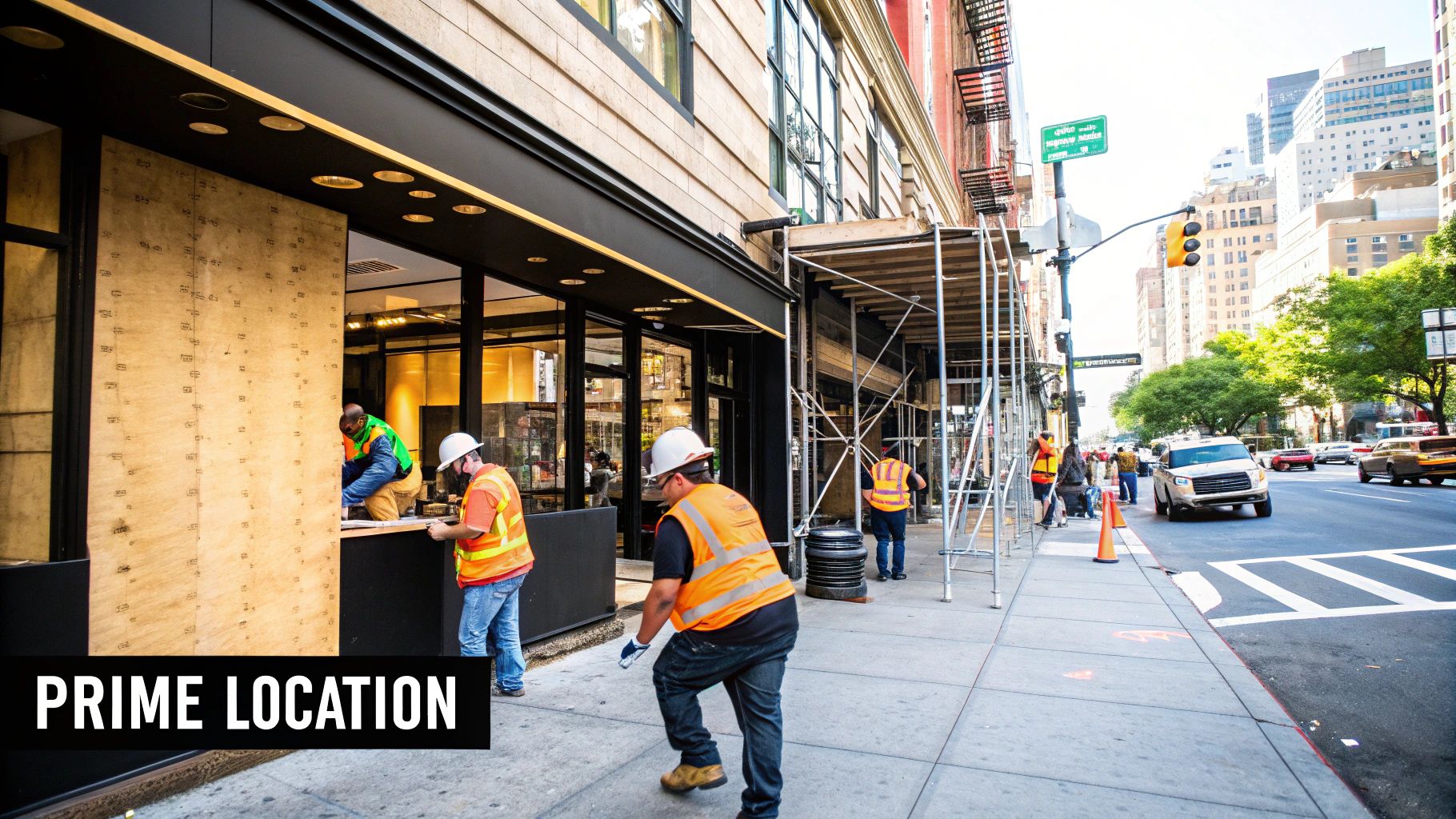
You can have the most brilliant concept and a rock-solid business plan, but without capital, they're just ideas on paper. Securing funding is often the biggest mountain to climb when launching a restaurant, and it's a journey you'll take while simultaneously navigating a maze of legal requirements. Both demand your full attention.
The first real step is to pin down your startup costs. This isn't about a ballpark figure; it's a granular forecast that potential lenders will pick apart. You need to break down every single expense, from the big-ticket kitchen equipment down to the easily forgotten costs that can bleed a new business dry.
This detailed budget is the bedrock of your funding proposal, whether you're walking into a bank or pitching to a private investor.
Funding Your Fast Food Dream
There are several roads you can take to finance your venture, and each has its own upsides and downsides. There’s no single right answer, so you’ll have to figure out which path makes the most sense for your financial situation and long-term goals.
- Traditional Bank Loans: This is the classic route, but be prepared for scrutiny. Banks are notoriously risk-averse and will demand a flawless business plan, a strong personal credit history, and usually some kind of collateral.
- SBA Loans: Backed by the Small Business Administration, these loans can be a bit easier to get. The government guarantee lowers the bank's risk, making them more willing to lend. The application process can be a slog, but the favorable terms make it a top choice for many.
- Private or Angel Investors: Pitching to investors is all about selling the dream and the profit potential. In return for cash, you’ll almost certainly give up a slice of ownership in your company. The major upside here can be the mentorship and connections that often come with the money.
No matter who you're asking for money, a well-defined budget is your most powerful tool. It shows you've done your homework and can be trusted to manage their investment wisely.
To really nail this part, robust financial planning for business owners is non-negotiable. A clear financial plan proves you have a credible path to profitability.
Demystifying Startup Costs
A thorough budget needs to cover every single expense you can think of before you open the doors. Missing a major category can put your entire operation in jeopardy before you've even sold your first burger.
Here’s a checklist to get you started:
- Real Estate Costs: Think security deposit, first month's rent, and any broker fees.
- Renovation & Build-Out: The cost to turn an empty shell into your restaurant. This covers construction, plumbing, electrical, and design.
- Kitchen Equipment & Supplies: This is one of your biggest line items. It includes everything from commercial fryers and grills to walk-in coolers and prep tables. For a deep dive, this guide to https://encoreseattle.com/blogs/seattle-restaurant-equipment/commercial-kitchen-design-layout is a fantastic resource.
- Initial Inventory: Your first big order of all food, drinks, and packaging to get you through the first week or so.
- Technology: Your Point of Sale (POS) system, kitchen display screens (KDS), and any security cameras.
- Licenses & Permits: The fees for all the required legal paperwork, which can vary wildly depending on your city and state.
- Initial Marketing & Grand Opening: You need to budget for creating a buzz and getting those first customers in the door.
- Working Capital: This is crucial. You need at least 3-6 months of operating expenses (payroll, rent, utilities) sitting in the bank to keep you afloat before you start turning a profit.
Staying on the Right Side of the Law
At the same time you're chasing funding, you have to start tackling the legal paperwork. Dropping the ball here can mean huge fines or, even worse, a delayed opening that costs you a fortune. Start this process early—some permits can take months to get approved.
You'll almost certainly need these key documents:
- Business License: The basic permit to operate legally in your town or county.
- Employer Identification Number (EIN): You’ll need this from the IRS for tax purposes as soon as you hire your first employee.
- Food Service License: Your local health department issues this after an inspection to confirm your kitchen meets all safety and sanitation codes.
- Food Handler's Permits: In most places, every single staff member who touches food will need to get one of these.
Getting through the financial and legal hoops is a massive part of the startup journey. A disciplined, organized approach is the only way to avoid costly mistakes and build a stable foundation for your launch.
Choosing Your Location and Designing an Efficient Kitchen
In the world of fast food, two things make or break you: where you are and how fast you can serve. Your location is your lifeblood, determining who walks through your door. Your kitchen layout? That's your engine, dictating the speed and efficiency that keeps them coming back. You absolutely have to nail both.
The hunt for that perfect spot isn't about finding a place with a "good vibe." It's a mission, and it's driven by cold, hard data. High visibility is a great start, but it's just one piece of a much larger puzzle. You need to become a local expert, digging into traffic patterns, demographics, and the competition.
Finding the Perfect Spot
Your ideal location should feel like a natural fit for the customer you defined in your business plan. If you're slinging premium burgers for the lunch crowd, a downtown spot with heavy foot traffic is a no-brainer. But if your game is family-friendly meals, you're better off in a suburban shopping center with plenty of parking.
Before you even think about signing a lease, get granular with this data:
- Vehicle and Foot Traffic: Don't just guess. Get the actual numbers. Commercial real estate brokers often have this info. The key isn't just how many people pass by, but when they do. Is it a lunch rush, a dinner crowd, or steady all day?
- Local Demographics: Pull the census data. Look at income levels, age brackets, and family sizes in the immediate area. If your target is young professionals and the area is mostly retirees, you've got a mismatch.
- The Competitive Landscape: Literally map out every other quick-service restaurant in a one-mile radius. Sometimes, a cluster of fast-food joints creates a "food destination," which can be a good thing. But you have to be brutally honest about whether your concept is strong enough to stand out.
- Accessibility and Visibility: This is huge. Can people easily turn into your lot from a busy street? Or is it a nightmare of a left turn during rush hour? Can your sign be seen from a block away? These small friction points can be silent business killers.
You'll also need to decide on the type of property. A standalone building gives you ultimate brand control and the potential for that all-important drive-thru, but it comes with a much higher price tag. On the other hand, a spot in a bustling food court or strip mall offers built-in traffic, but you might be stuck with limited hours or restrictive signage rules.
Your location is a long-term commitment. It's incredibly difficult and expensive to fix a bad choice. Rushing this decision is one of the most common—and most devastating—mistakes I see new owners make.
Engineering a Kitchen Built for Speed
Once you've planted your flag, it's time to build the engine. Your kitchen isn't just a place to cook; it's the heart of your entire operation. A clunky, inefficient layout creates bottlenecks, slows down service, and bleeds money. The goal is simple: create a logical workflow that minimizes wasted steps and maximizes output.
The quick-service restaurant (QSR) industry is an absolute powerhouse, valued at around USD 265.86 billion and expected to climb to nearly USD 381.79 billion by 2033. That growth is fueled by customers who demand speed and convenience, whether they're dining in, hitting the drive-thru, or ordering delivery. An efficient kitchen is the only way you can keep up.
A well-designed fast food kitchen operates like a finely tuned assembly line. It’s organized into dedicated zones—prep, grill, fry, assembly, and expo—so your team isn't constantly bumping into each other. Every order should flow smoothly in one direction, from the moment it's placed to the second it's handed to the customer.
This kind of strategic thinking applies to your menu, too, which directly impacts your kitchen design.
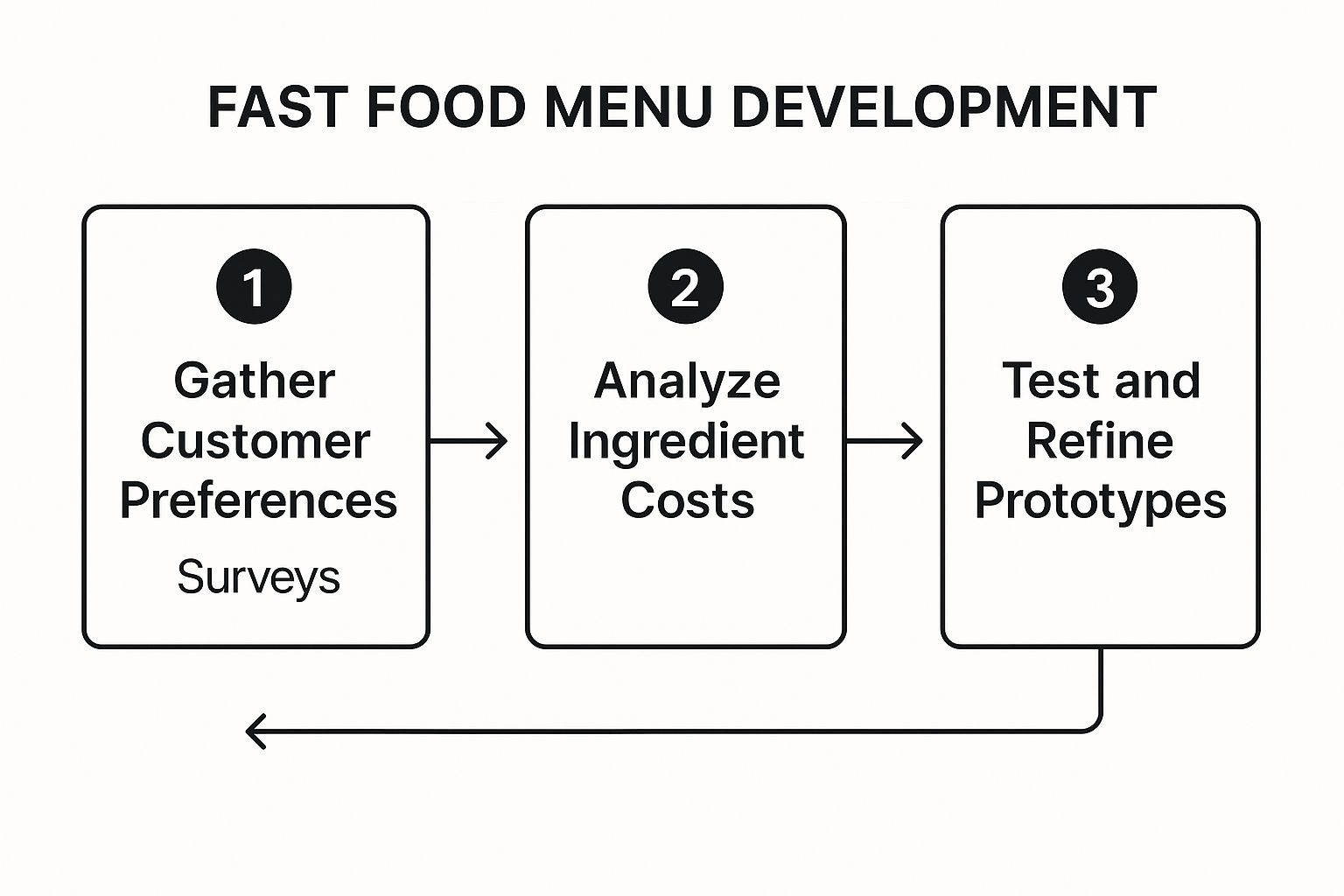
As you can see, a great menu comes from a clear process of understanding customer wants, crunching the numbers on costs, and testing your products. Those same principles—customer needs, cost, and testing—are exactly what should guide your kitchen layout and equipment choices.
Sourcing Essential Restaurant Equipment and Supplies
With your floor plan mapped out, it's time to gear up. This is where you invest in the tools of the trade, and it's not the place to be cheap. You need commercial-grade equipment that can handle the relentless pace of a busy service and meet all health code standards. I’ve seen people try to save a few bucks with residential appliances. Trust me, they just can't take the punishment.
The equipment you need is dictated entirely by what's on your menu. A burger joint's shopping list will be heavy on high-capacity grills and deep fryers, while a sub shop will focus on refrigerated prep tables, deli slicers, and speed ovens.
To get you started, here’s a quick look at the essentials every fast food kitchen needs to consider.
Essential Fast Food Kitchen Equipment Checklist
| Equipment Category | Essential Items | Key Considerations |
|---|---|---|
| Cooking Equipment | Commercial Fryers, Grills/Griddles, Ovens | Think about capacity, energy efficiency (gas vs. electric), and how quickly the equipment recovers temperature during a rush. |
| Refrigeration | Walk-in Cooler/Freezer, Reach-in Coolers, Prep Tables | Size is critical, but so are temperature consistency and how easy the units are to clean and maintain. |
| Food Preparation | Stainless Steel Prep Tables, Sinks, Food Processors | Look for durability and NSF certification for sanitation. Make sure the pieces fit logically into your workflow. |
| Point of Sale (POS) | POS Terminal, Kitchen Display System (KDS), Printers | Your POS should integrate seamlessly with online ordering and inventory tracking. It also has to be dead simple for your crew to use. |
Making a detailed list is one of the most important steps you'll take. To make sure nothing falls through the cracks, use a guide like this comprehensive commercial kitchen equipment checklist to break down everything you'll need.
This is a major investment. Planning it carefully is the only way to ensure your kitchen is ready to fire on all cylinders from day one.
Building Your Menu and Assembling Your Team
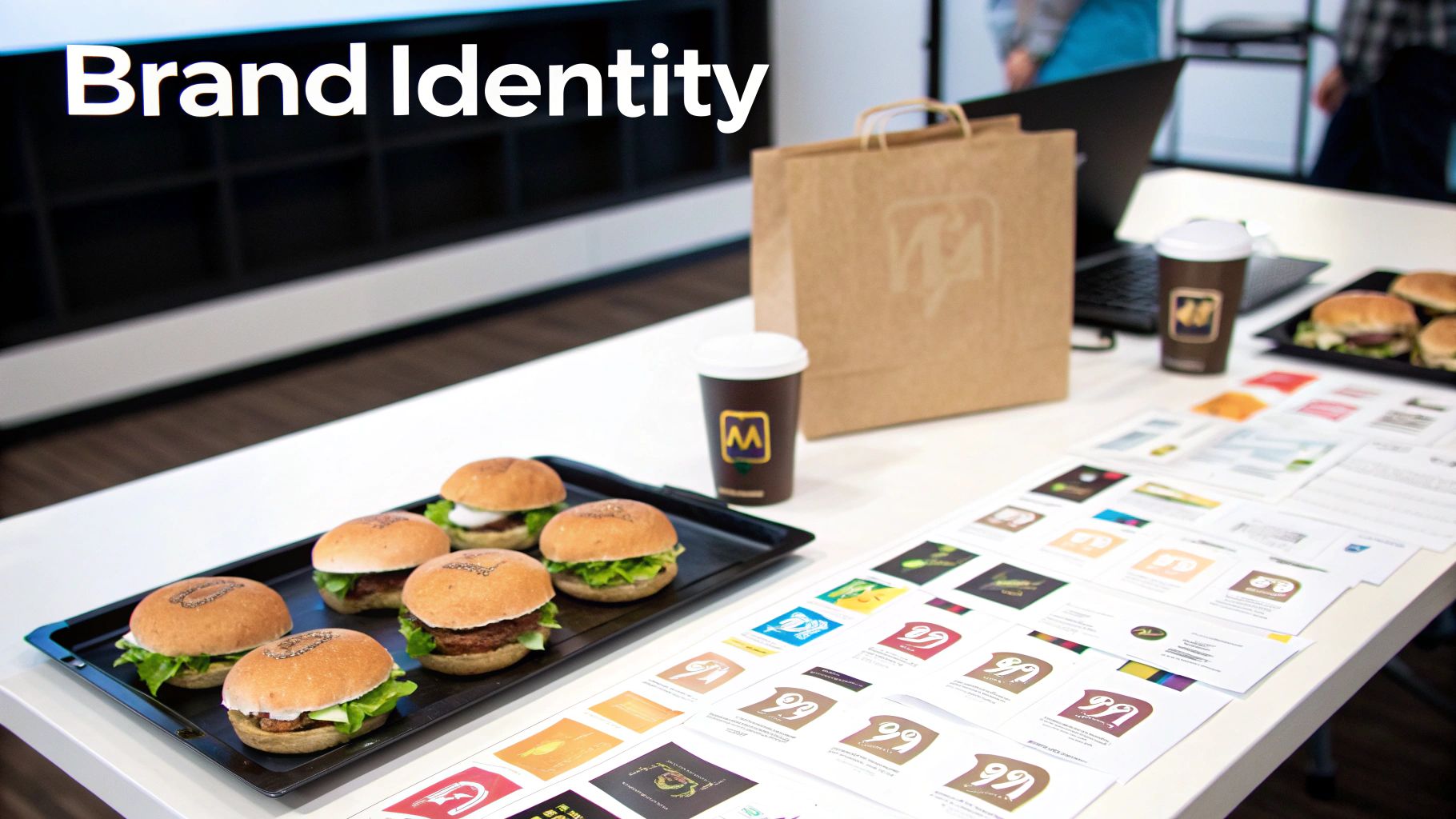
Alright, you've locked down a location and designed a kitchen built for speed. Now it's time to focus on the heart and soul of your restaurant: the food you serve and the people who make it all happen. Think of your menu as your promise to the customer and your team as the people who deliver on that promise, day in and day out. Getting both of these right is absolutely crucial.
The fast food market is growing at an incredible pace, set to jump from USD 972.74 billion in 2021 to a staggering USD 1,467.04 billion by 2028. This boom is all about consumer demand for quick, easy meals. For a new entrepreneur, that means a massive opportunity is sitting right there, waiting to be grabbed. To get your slice, you need a killer menu that’s actually profitable. Take a look at the latest fast food market trends to get a feel for what’s driving this growth.
The Art and Science of Menu Engineering
Your menu can't just be a list of things that taste good. It needs to be your silent salesperson, subtly guiding customers toward your most profitable items. This is called menu engineering, and it’s part science, part psychology. The real goal here is to create a menu that’s easy to read, simple for your crew to execute, and built to make you money.
The first thing you have to do is calculate the food cost percentage for every single item on your menu. This means adding up the cost of every last ingredient in a dish and then dividing that number by its menu price. For fast food, you’re aiming for a sweet spot between 25-35%. If you creep much higher than that, you’re literally eating into your own profits with every sale.
Your menu isn't just a list of what you sell; it's a strategic tool that directly impacts your bottom line. Every item, price, and placement should be a deliberate decision designed to drive profitability and customer satisfaction.
Once you know your costs, you can price things strategically. Don't just slap the same markup on everything. You want to find a balance, highlighting your "stars" (items that are both popular and highly profitable) while maybe finding creative ways to promote your "puzzles" (profitable, but not as popular).
Finding Reliable Suppliers
The quality of your ingredients is everything. It's the foundation of every dish you serve. That's why building solid relationships with reliable suppliers is one of the most important things you'll do. You need fresh, consistent ingredients delivered on time, every time. Don’t just chase the lowest price.
When vetting suppliers, dig a little deeper:
- Consistency and Quality: Can they guarantee the exact same product week after week? Your customers will notice if the quality dips.
- Delivery Schedule: Does their delivery window actually work for you? You need a partner who can fit into your prep and storage schedule, not the other way around.
- Pricing and Payment Terms: Sure, get competitive pricing. But also ask about payment terms that work with your cash flow projections.
- Local Sourcing: Working with local farms for produce can be a huge marketing win. Plus, it often means you get fresher, better-tasting ingredients.
Hiring Your First Employees
In the fast-paced world of QSR, your team is your biggest asset. My advice? Hire for attitude and train for skill. The perfect fast food employee is someone who can handle the rush with a smile, work fast without getting sloppy, and deliver great service every single time.
When you're interviewing, get past the generic questions. I look for a few key traits:
- Composure Under Pressure: Ask them to tell you about a time they dealt with a really stressful situation or an angry customer. The story they tell reveals way more than a simple, "I work well under pressure."
- A Sense of Urgency: This business is all about speed. You want people who are naturally energetic and get the need to hustle.
- Team-Oriented Mindset: Make it clear that everyone, from the person on the register to the one on the grill, is critical. Ask them how they’ve helped a team win in a past job.
Implementing a Strong Training Program
Once you have your people, you need a solid training program to make sure everyone is on the same page from day one. Please, don't just throw them to the wolves. A great training plan doesn’t just cover how to do something; it explains why it's done that way.
Your program needs to include hands-on training at every station, crystal-clear instructions on food safety, and even some role-playing for tricky customer interactions. When you invest in proper training, you give your team the confidence to do their jobs well, which means fewer mistakes and a better, more consistent experience for your customers. That’s how you turn first-time visitors into loyal regulars.
Launching and Marketing Your Restaurant
The build-out is finished, the kitchen gleams, and your staff is ready to go. You're about to open the doors, which feels like the finish line, but it’s really just the beginning. Now comes the hard part: getting people to walk through those doors.
A great restaurant launch isn't just about unlocking the door on day one. It's a full-blown campaign you start weeks in advance to build a groundswell of excitement and make sure you have a line of hungry customers from the moment you open.
Building Buzz Before Day One
The goal here is to make your grand opening feel like an unmissable community event. Weeks before you plan to serve a single customer, get your social media profiles live on platforms like Instagram or TikTok—wherever your ideal diners are scrolling.
This is your chance to start telling your story. Use these channels for sneak peeks of the menu, behind-the-scenes shots of the space coming together, and introductions to your chef and team. Are you a family spot using a secret recipe passed down for generations? Share that. Are you all about farm-to-table? Show off your local farm partners. This is how you build an emotional connection before they've even tasted the food.
The best pre-launch marketing isn’t about selling at all. It’s about storytelling. You’re inviting people on the journey with you, making them feel like insiders from the very beginning.
Don't be shy about reaching out. Connect with local food bloggers, community Facebook groups, and influencers in your area. An invitation to a private pre-opening tasting can generate a ton of authentic social media buzz and word-of-mouth promotion that you just can't buy.
Executing a Memorable Grand Opening
Your grand opening is your restaurant’s debut. It sets the tone for everything that follows and is your one shot to make a huge first impression. You want to create an experience that’s fun, memorable, and gets people excited to come back.
A "Grand Opening" banner alone won't cut it. You need to make some noise.
- Create an irresistible offer. Think "first 100 customers get a free burger" or "50% off all day." This creates a sense of urgency and practically guarantees a line.
- Make it a party. Hire a local musician, rent a photo booth with your logo on the prints, or have some simple branded giveaways. It should feel like a true celebration.
- Get the word out. Send a press release to local news stations, radio shows, and community calendars. Make sure everyone knows what’s happening.
This is a make-or-break moment, and it’s easy to let small details slip through the cracks when things get chaotic. To stay organized, a solid checklist is your best friend. For a complete rundown, check out this invaluable checklist for a restaurant opening to keep your launch on the right track.
Sustaining Momentum for the Long Haul
The initial hype of a grand opening is fantastic, but it won’t last forever. Lasting success is built on consistent, smart marketing that keeps your restaurant top-of-mind, bringing in new faces while turning first-timers into regulars.
Your digital storefront is now just as important as your physical one. As you get ready to launch, a polished website is non-negotiable. You can use great, intuitive tools like Framer for website design to build a site that looks professional without needing a team of developers. Your site must be mobile-friendly, display your menu clearly, and, if possible, have online ordering built right in.
Mastering Your Digital and Local Marketing
Once your website is live, you need to make sure people can actually find it. This is where local SEO becomes your secret weapon. Claim and meticulously fill out your Google Business Profile. I'm talking high-quality photos, updated hours, your full menu, and actively encouraging customers to leave reviews. Showing up when someone nearby searches for "food near me" is one of the most powerful ways to get new customers who are ready to eat right now.
Your social media needs to evolve, too. Shift from pre-launch hype to ongoing engagement. A simple content calendar can make all the difference. Make sure it includes:
- Mouth-watering food photos. Your food has to look as good online as it tastes in person.
- Customer content. Encourage people to tag you in their posts and re-share the best ones. It’s free, authentic advertising.
- Specials and promotions. Use your channels to announce daily deals or limited-time offers.
And don't forget about the real world. Simple, old-school tactics still work wonders. A "buy ten, get one free" punch card is incredibly effective for driving repeat business. You can also build steady revenue streams by partnering with nearby offices, schools, or other businesses for catering deals or cross-promotions. Marketing isn't a one-and-done task—it's the ongoing work of connecting with your community.
Common Questions About Starting a Fast Food Business
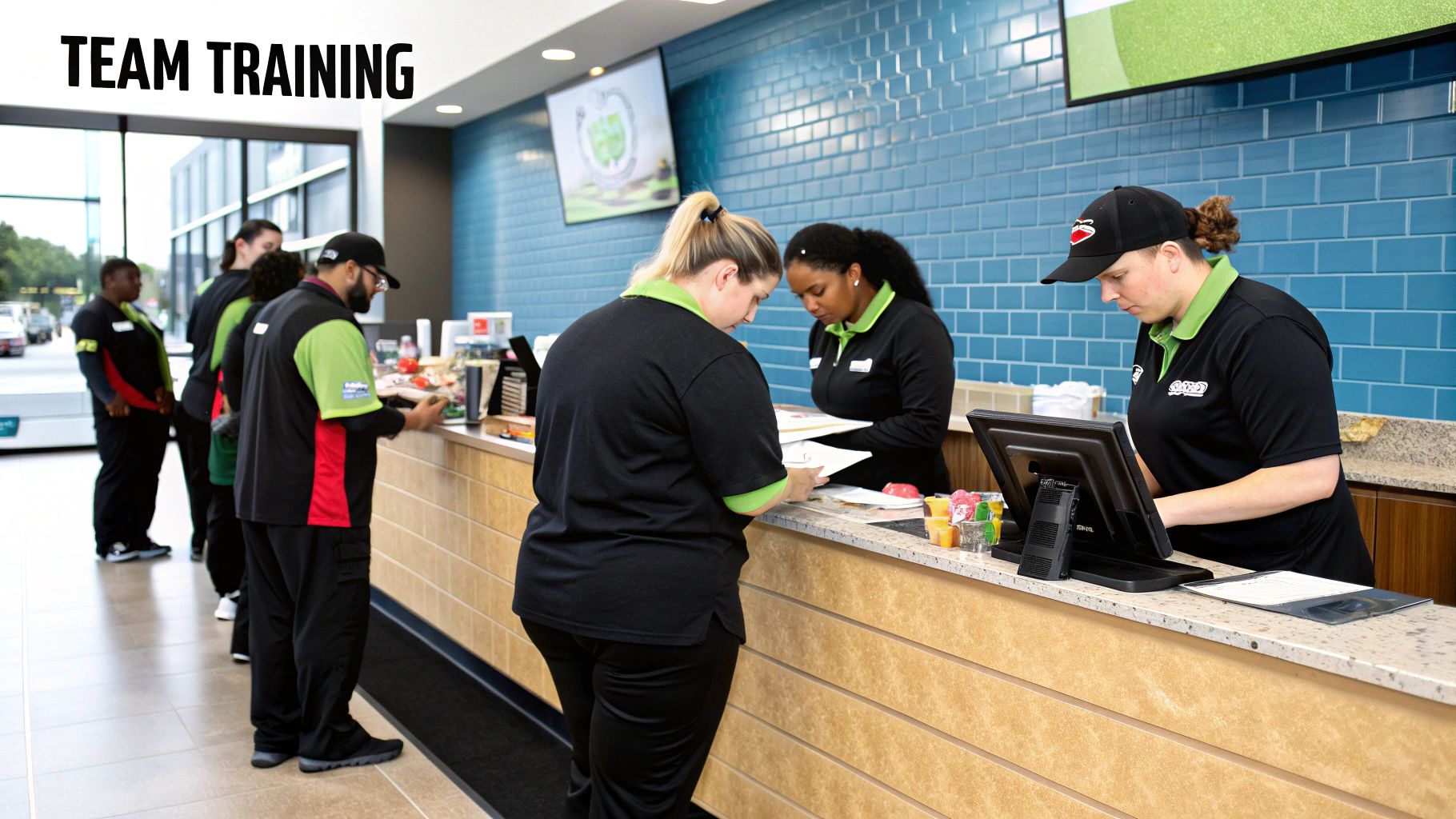
Jumping into the fast food world is exciting, but it naturally comes with a lot of questions. Getting straight answers from the get-go is the best way to build your confidence and sidestep the common traps that trip up so many new owners.
Let's tackle some of the biggest questions I hear from aspiring restaurateurs.
How Much Does It Realistically Cost to Start?
There's no single magic number, as costs can swing wildly depending on your city, concept, and square footage. But, to give you a solid ballpark, you should probably plan for a range between $100,000 and $500,000. That number looks intimidating, I know, but it makes more sense when you see where the money goes.
Here’s a rough breakdown of your major expenses:
- Lease and Build-Out: This covers your deposit and any construction needed to transform a space into your vision, from plumbing and electrical to flooring and paint.
- Kitchen Equipment: This is one of your biggest line items. Think commercial-grade grills, fryers, ventilation hoods, walk-in coolers, and of course, your Point of Sale (POS) system.
- Initial Inventory: You'll need a massive first order of food, drinks, paper goods, and cleaning supplies to get you through the opening rush and beyond.
- Licenses and Permits: The fees for your business license, health department permits, and other local requirements can add up faster than you'd think.
A piece of advice I can't stress enough: Have at least three to six months of operating capital in the bank before you open. This cash cushion is your safety net for rent, payroll, and utilities while you're still building a steady customer base.
What Are the Most Common Mistakes New Owners Make?
I've seen so many passionate people make the same few mistakes that put their dream on the line. Just knowing what they are can help you avoid them. The number one killer is underestimating startup costs and simply running out of cash.
Another classic blunder is picking the wrong location. You can have the best burger in town, but if you're hidden away with no parking or foot traffic, nobody will ever know. It’s all about visibility and convenience.
On the operations side, a menu that's too big or complicated is a recipe for disaster in a fast food setting. It kills your ticket times and creates chaos in the kitchen. Finally, a surprising number of owners think "if you build it, they will come." You absolutely have to market your restaurant before, during, and after your grand opening to build and maintain momentum.
How Important Is Technology for a New Restaurant?
It’s not just important; it's essential. In today's market, technology is the backbone of any successful fast food spot. Your Point of Sale (POS) system is command central—it’s how you take orders, process payments, and track sales data that tells you what's working and what isn't.
But it goes way beyond that. Customers now expect to be able to order from you online. Whether it’s through your own website or a third-party app like DoorDash or Uber Eats, online ordering isn't a bonus feature anymore; it’s a core part of the business.
And don't forget about marketing. A well-managed social media presence and a focus on showing up in local Google searches are crucial for getting hungry customers to find you in the first place. Think of technology as your most efficient employee.
For every step of your journey, from planning your kitchen layout to sourcing reliable equipment, Encore Seattle Restaurant Equipment is here to help. Discover top brand names at unbeatable prices and get the expert guidance you need to build the fast food business of your dreams. Explore our extensive inventory and financing solutions at https://encoreseattle.com.
